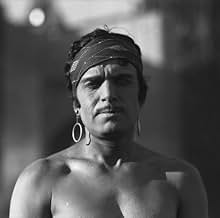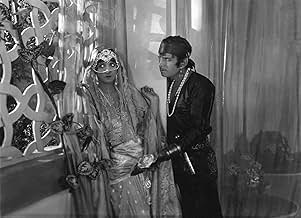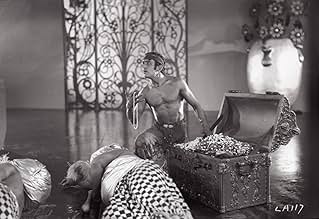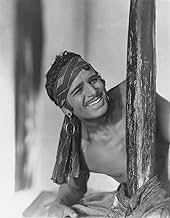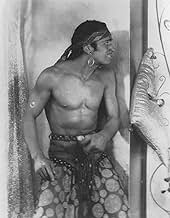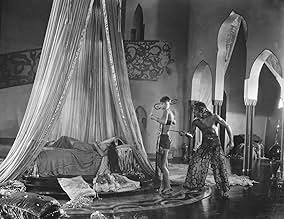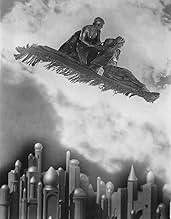Un ladrón reincidente compite con un engañoso gobernante mongol por la mano de una bella princesa.Un ladrón reincidente compite con un engañoso gobernante mongol por la mano de una bella princesa.Un ladrón reincidente compite con un engañoso gobernante mongol por la mano de una bella princesa.
- Dirección
- Guionistas
- Elenco
- Premios
- 4 premios ganados en total
- The Mongol Prince
- (as Sojin)
- Page Boy
- (sin créditos)
- Page Boy
- (sin créditos)
- Persian Prince
- (sin créditos)
- Mongol Prince's Court Magician
- (sin créditos)
- Child
- (sin créditos)
- Slave of the Sand Board
- (sin créditos)
Opiniones destacadas
It's star attraction, Douglas Fairbanks, having made a reputation for himself in costume swashbucklers, previously appearing as Zorro, Robin Hood and the leader of The Three Musketeers, assumes another challenge, an Arabian Nights Fantasy. Fairbanks is cast as The Thief (no actual name given), in the crowded city of Bagdad. Almost immediately, the Thief, bare-chested and sporting baggy pants resembling the bottom half of a pajama, lives up to his title picking pockets, stealing food from the ledge of a balcony, and living by his philosophy, "What I want, I take." The movie opens and closes with a Holy Man (Charles Belcher) raising his arm towards the glittering stars in the heavens spelling out "Happiness Must Be Earned." In between those words, the moral of the story is told to a young lad how this thief earned his happiness.
Lengthly with some lulls, THE THIEF OF BAGDAD never ceases to amaze. Compared to the 1940 Technicolor sound adaptation starring Sabu, where both versions differ, the sole focus being on fantasy, with highlights being the flying carpet and a nasty villain. The Fairbanks version doesn't include what many would expect to see, a genie from the magic lamp granting three wishes. It doesn't really matter because the 1924 production has enough magic and visual fantasies to go around. Fairbanks excels in his role by climbing a magic rope, riding a winged horse across the clouds, fighting underwater sea monsters, and his battle with the valley of fore. The special effects reaches its climax where the thief materializes his army of thousands, possibly millions, from puffs of smoke, entering the castle by wrapping himself with an invisible cloak, whisking by his enemies. A magical tale, brilliantly told, full of surprises too plentiful to mention here.
THE THIEF OF BAGDAD is Douglas Fairbanks' finest hours on screen. Aside from being in a far away land, Doug resumes his athletic skills as in previous films, ranging from visual stunts to his trademark smile. It's unlike anything he has ever done before and something that could only be accomplished on screen once. Reportedly the first million dollar production, every penny of it shows on screen. How fortunate for THE THIEF OF BAGDAD not to have ever been the victim of neglect and put on the list among many titles as a "lost" film? How many lavish film productions such as this will never see the light again? The Douglas Fairbanks legend lives on with films such as this.
A supporting cast of not so famous performers, only Anna May Wong as the Mongol Slave, did make a name for herself in future films up to the sound era. Julanne Johnston, possibly a screen beauty that will never be known considering she spends the entire time with her face covered by a veil. Aside from Brandon Hurst (Caliph), and Noble Johnson (the Indian Prince), Sojin stands out in his spine chilling performance as the evil Mongol Prince.
THE THIEF OF BADGAD was one of 13 feature films broadcast on the PBS 13-week series, "The Silent Years" (1971), hosted by Orson Welles. Before the start of the movie, Welles talks about how the movie influenced him as a boy, having seen it multiple times in the theater. Though its TV presentation runs 132 minutes, missing footage would be restored in later years, including the underwater sequence as the Thief encounters a harem of beautiful maidens; the thief's battle with a prehistoric bird; as well as his encounter with a living statue with foot long fingernails. Video copies since the 1980s were distributed in various ways. Companies carrying public domain titles at bargain prices would distribute this very long movie minus any type of music soundtrack. Other distributors, namely Blackhawk, contained organ scoring by Gaylord Carter, while others had Thames Orchestration. THE THIEF OF BAGDAD has been available at different time lengths as well, with the standard being 150 minutes. There have been others as Video Yesteryear to have distributed a print as long as three hours at correct silent speed. The KINO company includes what's been missing from numerous prints over the years, that being the cast listing of actors in its conclusion. Aside from the wonders of video and current DVD, THE THIEF OF BAGDAD, which did get some exposure on American Movie Classics (1997) and Turner Classic Movies' "Silent Sunday Nights," hosted by Robert Osborne with Gaylord Carter organ scoring, since September 10, 2013, it's been presented on TCM accompanied by Carl Davis Orchestration from the Thames Video Collection.
In closing, THE THIEF OF BAGDAD is worthy screen entertainment for all ages and future generations to come. The thought of this to still be available and appreciated today would have made Fairbanks proud, thus, the moral of the story, "Happiness Must Be Earned." (****)
The imagination and power of the visual design of the sets by Raoul Walsh make a nice complement for Fairbanks' script. Having read some of the original material from Sir Richard Burton's unexpurgiated translation of the Arabian Nights (that is, the uncensored, unwatered-down version that most of the general public is familiar with), I can honestly say that, while this story is in none of the tales I read, it would have been a perfect fit within Scherazade's many fantastic tales of moral instruction. The language, the situations, the magical artifacts, the transformation of a callow youth into a great (if still wily and underhanded) hero...they all so accurately reflect the atmosphere of those wondrous tales that I have read and enjoyed.
As for Fairbanks himself, well...is there any red-blooded American boy who HASN'T wanted to be like him? Maybe the boys of today wouldn't recognize the name, but five bucks says that they would definitely recognize the attitude and the style. Charming, smart, irresistable to women, tough enough to take on the bad guys, gifted with a physique that borders on the unbelievable...he's every boy's greatest heroic fantasy come true.
All that said, another reason "The Thief of Bagdad" is important AND fun is because it really marks the starting point for the modern genre of action-adventure films. The use of humor is extensive (my favorite bit being Fairbank's method of "touching" a particular bush), helping keep things from becoming TOO serious for it's own good. Then there's the use of special effects, some very hokey by today's standards, but probably state-of-the-art for it's time and still very impressive, considering the time period this film was made. There's also the touch of romance that helps sweeten the tone. Though subsequent offerings have not had as deft a touch as this film does, this would be a logical beginning to that tradition. Finally, there's the final confrontation between the protagonist and antagonist, but I truly doubt that anyone has ever come up with a showdown that relied more on brains than brawn as this one.
Don't let the age of this film offput you. Like it's inspiration, it weaves Scherazade's song with a melody that has yet to be outdone (though it has been matched during subsequent decades).
"Thief of Bagdad" was made in 1924 when Fairbanks was half way through the heyday of that part of his career. He already had "Zorro" "The Three Musketeers" and "Robin Hood" behind him. "Thief" was something of a departure, however, for it depended less on Fairbanks ability to dance his way though physical stunts than it did on the Arabian Nights tableau it presented on the screen. And frankly, nothing like it has every been done since. Only Griffth's "Intolerance" created the same kind of feel, and it was gritty and warlike, where as "Thief" was a sort of wondrous dream about what it would be like to live by your wits, go off and slay dragons and eventually, win the hand of a princess by saving her father's kingdom.
Fairbanks was over 40 when he made this film and yet seems so perfectly suited for it that we forget his age. He is the embodiment of the dashing hero.
But what almost overshadows him are the sets themselves. Designed by William Cameron Menzies, they are beyond spectacular. Almost every frame of this film is a work of art and of course, the amazing thing is, this was not done through computer animation. So skillful are the designs and the camera-work, that it is almost impossible to tell where the sets stop and the matte paintings begin.
Credit for all this must also go to Fairbanks,who wrote the script and produced the film. Raoul Walsh's direction is also great, although the film is a little long in some spots and would be aided by some skillful editing.
Fairbanks acting style seems today very much of the silent era, yet at the same time, there is always the feel of joyous celebration to it. He was always something of the happy rogue or perhaps, a guy who realized he was getting to make a living by playing in the world's most wonderful sandbox. He was blessed with good fortune and he knew it.
Of the others, Julanne Johnston, who plays the princess, probably comes off the worst of the main characters. She is beautiful,but comes off as little more than window dressing. But kudos to the incredible Anna May Wong who plays the treacherous Mongol slave girl. Wong's great beauty and strong screen presence allow her to steal almost every scene she is in. That Wong never got the chance to play many lead roles is one of the great tragedies of Hollywood history.
Douglas Fairbanks is totally great in this one. He looks, acts, breaths, eats like a real superstar. He handles all of the athletic action in the movie really well. It's not hard to see why this man was THE swashbuckling hero of the '20's.
The movie is really great looking, with many grand looking sets. Really great looking stuff! (though obviously all fake.) Something you would normally expect to see in a D.W. Griffith movie. The movie also has some silly looking but yet great early special effects, toward the ending of the movie.
The story has all the ingredients needed for such a genre movie as this one; an heroic main character, a love interest, stereotypical villains and lots of fun and action. Especially toward the ending the movie starts to become greatly adventurous after a sort of slower middle and good first part. It's of course all rather simple and formulaic but this is also what makes the genre so great. You just always know what to expect. It's good simple fun that's professionally and well made, that's also beautiful to look at.
Also definitely fun to see how much of this movie was later used again in Disney's "Aladdin". Some, mostly action sequences, are obviously almost directly copied.
A great fun movie, from swashbuckling-specialist director Raoul Walsh.
9/10
http://bobafett1138.blogspot.com/
¿Sabías que…?
- TriviaFor the flying carpet effect, Douglas Fairbanks stood on a 3/4-inch thick sheet of steel attached to 16 piano wires and rigged to the top of a crane, which lifted him above the crowd.
- ErroresAt the 2 hour 27 minute mark when the thief and the princess are flying over Bagdad you can see piano wires holding up the flying carpet when the light reflects off them. You need to look carefully though.
- Citas
The Thief of Bagdad: I am not a prince. I am less than the slave who serves you-a wretched outcast-a thief. What I wanted, I took. I wanted you-I tried to take you-But when I held you in my arms-the very world did change. The evil within me died. I can bear a thousand tortures, endure a thousand deaths-but not thy tears.
Guard: This Arab Prince is but a thief. Seek him out!
The Princess: Quick! Hide thyself. If thou art found with me, they will be merciless. I love you.
- Versiones alternativasIn some prints, Mathilde Comont is credited as M. Comont to keep her sex a secret. However, in several scenes in the film it is very obvious that the Persian Prince is being played by a woman.
- ConexionesEdited into Michael Blanco (2004)
Selecciones populares
- How long is The Thief of Bagdad?Con tecnología de Alexa
Detalles
- Fecha de lanzamiento
- País de origen
- Idioma
- También se conoce como
- The Thief of Bagdad
- Locaciones de filmación
- Guadalupe-Nipomo Dunes, California, Estados Unidos(The Thief rides horse along dunes en route to save The Princess)
- Productora
- Ver más créditos de la compañía en IMDbPro
Taquilla
- Presupuesto
- USD 1,135,654 (estimado)
- Tiempo de ejecución2 horas 35 minutos
- Mezcla de sonido
- Relación de aspecto
- 1.33 : 1
Contribuir a esta página




